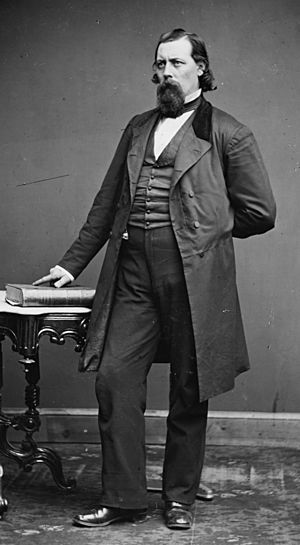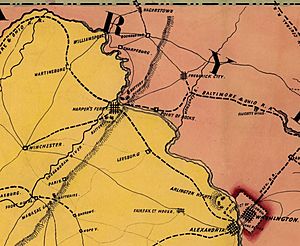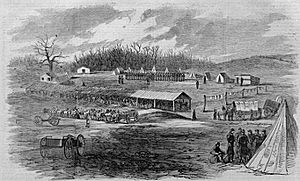Lamon's Brigade facts for kids
Lamon's Brigade was a special group of soldiers formed during the American Civil War. It wasn't an official name, but people called it that because it was put together by Ward Hill Lamon, who was a good friend of President Abraham Lincoln. Lamon also worked as the U.S. Marshall for the District of Columbia. This brigade started in Williamsport, Maryland, in June 1861 and continued through the end of that year. It was first meant to be made up of soldiers from Virginia who supported the Union (the North). However, most of the men who joined came from Maryland, Pennsylvania, and Illinois.
How Lamon's Brigade Started
Ward Hill Lamon was born in Frederick County, Virginia. When the Civil War began, he believed that many Virginians living near the Maryland border supported the Union. He thought he could gather a whole group of volunteers from these areas. On May 27, 1861, he wrote to President Lincoln about his idea, and Lincoln said yes!
Lamon began forming his group in Williamsport, Maryland, which is right across the border from Virginia. Some Virginians who had left their homes were already in Maryland. But even with their help, it was hard to find enough people to join.
On June 12, the New York Times newspaper reported that Lamon was asking all loyal Virginians to join up. It said that about 60 Virginians who had left the Confederate (Southern) army had already joined his camp in Williamsport. They had even chosen a captain and were the start of a new group.
However, another newspaper, the Baltimore Daily Exchange, reported on July 22 that Lamon's group was not doing well. It said he had not even found 100 men.
One part of Lamon's group, Company B, did come from Berkeley County. This county also sent five other groups to fight for the Confederacy and one more for the Union during the war.
Normally, a group of soldiers needed at least 85 men to be officially recognized and get supplies from the government. Lamon faced the problem of having to pay for his soldiers himself. But President Lincoln made a special exception for him. On June 25, Lincoln told Lamon that as soon as he got enough companies, he could have a U.S. officer officially sign them up. Lincoln wanted this done quietly, so it wouldn't become a common practice.
Since Lamon wasn't finding enough soldiers in Virginia and Maryland, he started looking further west to gather enough men for a larger force, known as a brigade.
The 39th Illinois, "Yates' Phalanx"
In September, Lamon traveled west through Pennsylvania to Illinois and Missouri. In Pennsylvania, he added two independent artillery companies to his brigade. These were Company C, called "Thompson's Battery," and Company F, called "Hampton's Battery." Both were mostly recruited in Pittsburgh. Company C also added 23 men from Maryland when they arrived in Williamsport. Four cavalry companies, which later became part of the 1st Maryland Cavalry, were also recruited in Pennsylvania for Lamon's group.
Lamon met with the governor of Illinois, Richard Yates. He asked if he could find new soldiers in Illinois for his brigade, mentioning he had already found some men in Chicago. Governor Yates said Lamon couldn't recruit for groups outside of Illinois. However, he offered Lamon the 39th Illinois Infantry regiment, which was nicknamed "Yates' Phalanx." This regiment was already counted for Illinois.
Lamon wasn't sure at first because he wanted to recruit the soldiers himself. But he later agreed to take the regiment for his brigade. Meanwhile, General Fremont had ordered the 39th Illinois to St. Louis. After some letters between Governor Yates and Fremont, the 39th Illinois was sent by train from St. Louis all the way to Williamsport, Maryland.
The cost of moving this regiment was very high, about $30,000. This led to a government investigation and some people criticized Lamon. They said he was pretending to be a brigadier general and even wearing the uniform. Governor Yates, however, defended Lamon. He said that Lamon did not claim to be a brigadier general and that his behavior was always respectful.
Railroad workers who testified during the investigation said that Lamon was introduced to them as a brigadier general and was wearing the uniform. He was given free travel to St. Louis and even had his own special train car. The committee suggested that Lamon should pay back the government for the travel costs, but this idea was not pursued further.
What Happened to the Brigade
Ward Lamon went back to his job as U.S. Marshall in Washington D.C. in November. The different groups of soldiers he had gathered were then put under the command of Colonel S.H. Leonard. Colonel Leonard's new group included the 39th Illinois, the 13th Massachusetts, the 12th Indiana, some artillery guns, three cavalry companies, and six companies of the 1st Virginia volunteers that Lamon had tried to recruit. In total, this new command had 3,524 men.
Lamon wanted his brigade to stay together. But on January 15, 1862, the U.S. Adjutant General (a high-ranking military officer) told the governor of Maryland that Lamon's companies needed to be combined with other Maryland regiments that weren't complete.
The artillery companies from Pennsylvania eventually went back to Pennsylvania after being part of the 1st Maryland Brigade for a few months. The four cavalry companies that were part of the 1st Virginia Volunteers became part of the 1st Maryland Cavalry. The four infantry companies became part of the 3rd Maryland Infantry. There are no more records of any Virginia companies being formed for Lamon's brigade after this.
The 39th Illinois, 13th Indiana, and 13th Massachusetts Infantry regiments were assigned to guard the railroad lines and important points along the upper Potomac River. They became part of General Nathaniel P. Banks' Division, which was part of the Army of the Potomac.




